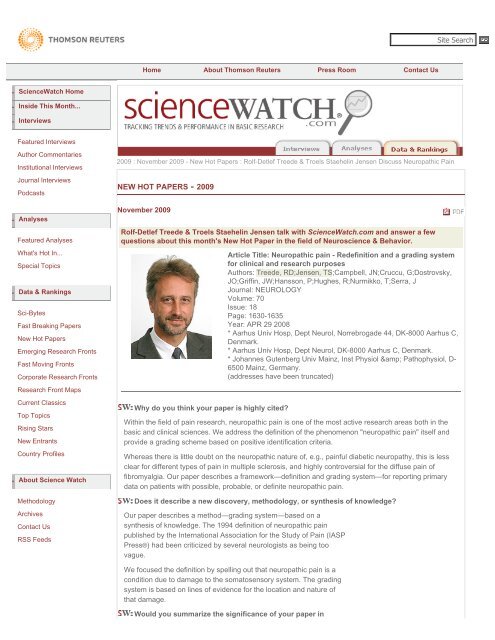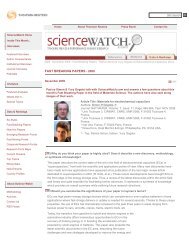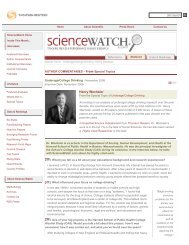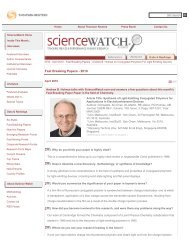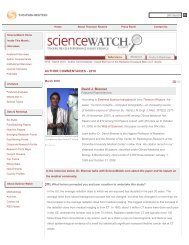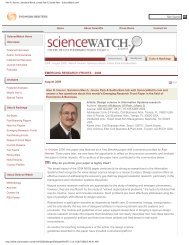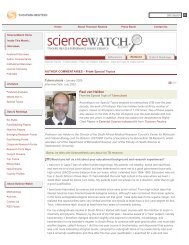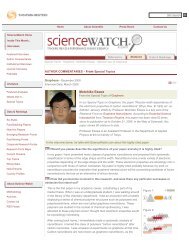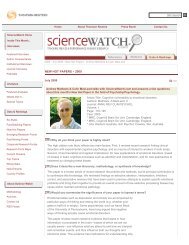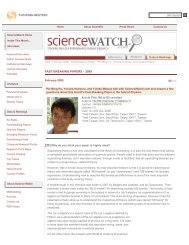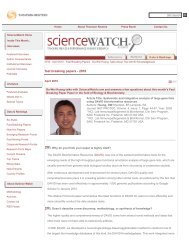Rolf-Detlef Treede & Troels Staehelin Jensen Discuss Neuropathic ...
Rolf-Detlef Treede & Troels Staehelin Jensen Discuss Neuropathic ...
Rolf-Detlef Treede & Troels Staehelin Jensen Discuss Neuropathic ...
You also want an ePaper? Increase the reach of your titles
YUMPU automatically turns print PDFs into web optimized ePapers that Google loves.
Home About Thomson Reuters Press Room Contact Us<br />
●<br />
●<br />
●<br />
ScienceWatch Home<br />
Inside This Month...<br />
Interviews<br />
Featured Interviews<br />
Author Commentaries<br />
Institutional Interviews<br />
Journal Interviews<br />
Podcasts<br />
2009 : November 2009 - New Hot Papers : <strong>Rolf</strong>-<strong>Detlef</strong> <strong>Treede</strong> & <strong>Troels</strong> <strong>Staehelin</strong> <strong>Jensen</strong> <strong>Discuss</strong> <strong>Neuropathic</strong> Pain<br />
NEW HOT PAPERS - 2009<br />
●<br />
●<br />
●<br />
Analyses<br />
Featured Analyses<br />
What's Hot In...<br />
Special Topics<br />
Data & Rankings<br />
Sci-Bytes<br />
Fast Breaking Papers<br />
New Hot Papers<br />
Emerging Research Fronts<br />
Fast Moving Fronts<br />
Corporate Research Fronts<br />
Research Front Maps<br />
Current Classics<br />
Top Topics<br />
Rising Stars<br />
New Entrants<br />
Country Profiles<br />
About Science Watch<br />
Methodology<br />
Archives<br />
Contact Us<br />
RSS Feeds<br />
November 2009<br />
<strong>Rolf</strong>-<strong>Detlef</strong> <strong>Treede</strong> & <strong>Troels</strong> <strong>Staehelin</strong> <strong>Jensen</strong> talk with ScienceWatch.com and answer a few<br />
questions about this month's New Hot Paper in the field of Neuroscience & Behavior.<br />
Why do you think your paper is highly cited<br />
Article Title: <strong>Neuropathic</strong> pain - Redefinition and a grading system<br />
for clinical and research purposes<br />
Authors: <strong>Treede</strong>, RD;<strong>Jensen</strong>, TS;Campbell, JN;Cruccu, G;Dostrovsky,<br />
JO;Griffin, JW;Hansson, P;Hughes, R;Nurmikko, T;Serra, J<br />
Journal: NEUROLOGY<br />
Volume: 70<br />
Issue: 18<br />
Page: 1630-1635<br />
Year: APR 29 2008<br />
* Aarhus Univ Hosp, Dept Neurol, Norrebrogade 44, DK-8000 Aarhus C,<br />
Denmark.<br />
* Aarhus Univ Hosp, Dept Neurol, DK-8000 Aarhus C, Denmark.<br />
* Johannes Gutenberg Univ Mainz, Inst Physiol <strong>&</strong>; Pathophysiol, D-<br />
6500 Mainz, Germany.<br />
(addresses have been truncated)<br />
Within the field of pain research, neuropathic pain is one of the most active research areas both in the<br />
basic and clinical sciences. We address the definition of the phenomenon "neuropathic pain" itself and<br />
provide a grading scheme based on positive identification criteria.<br />
Whereas there is little doubt on the neuropathic nature of, e.g., painful diabetic neuropathy, this is less<br />
clear for different types of pain in multiple sclerosis, and highly controversial for the diffuse pain of<br />
fibromyalgia. Our paper describes a framework—definition and grading system—for reporting primary<br />
data on patients with possible, probable, or definite neuropathic pain.<br />
Does it describe a new discovery, methodology, or synthesis of knowledge<br />
Our paper describes a method—grading system—based on a<br />
synthesis of knowledge. The 1994 definition of neuropathic pain<br />
published by the International Association for the Study of Pain (IASP<br />
Press®) had been criticized by several neurologists as being too<br />
vague.<br />
We focused the definition by spelling out that neuropathic pain is a<br />
condition due to damage to the somatosensory system. The grading<br />
system is based on lines of evidence for the location and nature of<br />
that damage.<br />
Would you summarize the significance of your paper in
layman's terms<br />
<strong>Neuropathic</strong> pain results from damage to the warning system of the<br />
body that normally signals impending injury to organs or tissues.<br />
Patients with neuropathic pain typically exhibit a mixture of sensory<br />
loss—reduced responsiveness to external stimuli—with ongoing<br />
spontaneous pain and sometimes enhanced sensitivity to externally<br />
applied painful stimuli (hyperalgesia).<br />
Our paper describes a refined definition for this type of pain together<br />
with a grading system. The grading system allows clinicians to<br />
communicate the level of evidence that they have obtained for a<br />
single patient on the neuropathic nature of the patient's pain<br />
complaint. Since treatment of neuropathic pain differs from that of<br />
other types of pain, better precision in diagnosis is expected to lead to<br />
a faster initiation of the appropriate treatment.<br />
Coauthor<br />
<strong>Troels</strong> <strong>Staehelin</strong> <strong>Jensen</strong><br />
How did you become involved in this research, and were<br />
there any problems along the way<br />
<strong>Rolf</strong>-<strong>Detlef</strong> <strong>Treede</strong>:<br />
This consensus process was initiated by Prof. <strong>Troels</strong> <strong>Jensen</strong>, and included the expertise of pain societies<br />
(IASP and its special interest group NeuPSIG) and neurological societies such as the European<br />
Federation of Neurological Societies (EFNS) and the American Academy of Neurology (AAN). As in any<br />
consensus process there was a heated scientific debate among coauthors on several aspects of our<br />
paper, which took a few years to resolve. We appreciate that this debate continued with the reviewers<br />
after submission of the manuscript, leading to further improvement in the phrasing of our statements.<br />
Where do you see your research leading in the future<br />
We anticipate better communication among researchers and among clinicians, when they use the<br />
proposed grading scheme to indicate the level of certainty that the pain state they describe is<br />
neuropathic in nature. We hope to see many empirical studies using the grading system, so it can be<br />
revised on an evidence-based level in a few years' time.<br />
Do you foresee any social or political implications for your research<br />
Yes, absolutely. If this proposal succeeds, neuropathic pain will ultimately be integrated into the nosology<br />
of neurological conditions, as headache already has. This should lead to more precise diagnosis of the<br />
neuropathic nature of a pain complaint, which in turn should guide a mechanism-based approach to pain<br />
therapy.<br />
Prof. Dr. med. <strong>Rolf</strong>-<strong>Detlef</strong> <strong>Treede</strong><br />
Lehrstuhl für Neurophysiologie<br />
Medizinische Fakultät Mannheim<br />
Universität Heidelberg<br />
Mannheim, Germany<br />
Web<br />
Prof. <strong>Troels</strong> <strong>Staehelin</strong> <strong>Jensen</strong>, M.D., Ph.D.<br />
Danish Pain Research Center<br />
Aarhus University Hospital<br />
Aarhus, Denmark<br />
Web<br />
KEYWORDS: MULTIPLE-SCLEROSIS; DIAGNOSTIC-CRITERIA; MECHANISMS; GUIDELINES; DEFINITION;<br />
SYMPTOMS; SIGNS.<br />
back to top<br />
2009 : November 2009 - New Hot Papers : <strong>Rolf</strong>-<strong>Detlef</strong> <strong>Treede</strong> & <strong>Troels</strong> <strong>Staehelin</strong> <strong>Jensen</strong> <strong>Discuss</strong><br />
<strong>Neuropathic</strong> Pain
Science Home | About Thomson Reuters | Site Search<br />
Copyright | Terms of Use | Privacy Policy


